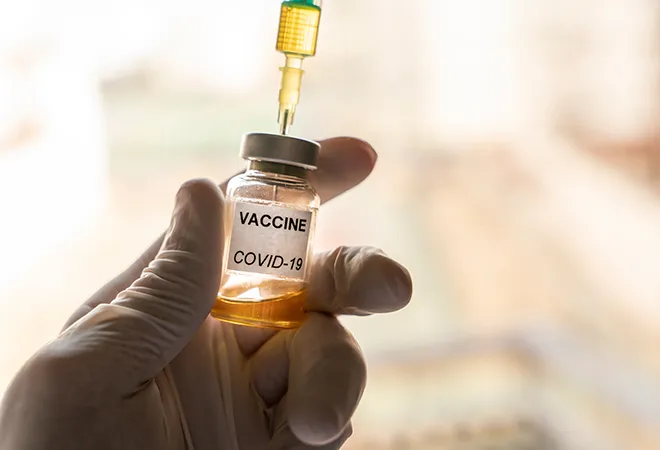
2020 -The Chinese year of the rat has turned out to be the year of the churn. It has pulled 7 billion humans together in the hope for fulfilment of a singular wish – a vaccine against the SARS-CoV-2 virus responsible for the COVID-19 pandemic.
Mired by Virus; Wired by Vaccine
No other event in human history – whether war, economy, natural calamity, celestial threat – managed to knot together the fate of the entire world, as has the CoVID-19 pandemic.
The story of another existential crisis from another time comes close. It is the fable of “Samudra Manthan” from the Hindu puranas. The crisis of the ancient mythical era is said to have taken the universe to the verge of destruction. The Creation would have been wiped off all life, had the Gods and demons not allied on a near-impossible mission - to obtain the pot of amrit (the nectar of health and immortality) from deep within the ocean bed. Together, the two warring factions churned the cosmic ocean and braved terminal distractions until they acquired amrit, to save the universe. Life continued thereafter, with all its verve and diversity.
The quest for COVID-19 vaccine(s) is no less arduous a task for scientists than the one above. Not only because vaccine development is complex and tough by its very nature, but due to a never-seen-before urgency. In short, the COVID-19 vaccine mission is expected to run at a pace about 10-15 times faster than that of a typical anti-viral vaccine project of the pre-COVID-19 world. For example, the lab to market journey ned over 15 years for the latest vaccine against Hepatitis B virus (affecting 257 million adults globally).
Normally, once a lab-proven vaccine candidate is validated safe-for-humans in early-stage trials, it is brought forward into Phase III pivotal trials for performance testing in thousands of people, recruited and observed over several years. The above mentioned Hepatitis B vaccine received the US FDA approval for human use in 2017, based on data from Phase 3 trials conducted over 5 years on 9,597 participants; with the entire project in the running for more than 15 years.
Starting from scratch, up to making packaged doses available for human use within 12-15 months of the outbreak indeed needs action at “warp speed”, also an apt pick as a moniker by the US Government for its COVID-19 vaccine project, Operation Warp Speed. With the civil society and governments rooting for it, the question on everyone’s mind is: when will the world have at least one COVID-19 vaccine?
For scientists, it is a burden of responsibility to ensure that speed does not compromise on safety, as they boldly face the following challenges, each one being exhaustingly wicked on its own.
Up Against Unknown: Is science agile to design new vaccines-artillery?
Scientists know which human cells are prone to SARS-CoV-2 virus attack (cells rich in receptors for angiotensin-converting enzyme 2 or ACE2). It is also known how the virus uses its spike protein to unlock the ACE2 receptor and enter the cell. Post-entry lies the world of the unknown. The mechanics of what the virus does within the body, and the extent of rampage it can cause is still a mystery; which means that critical information required to define the exact coordinates of protection or the goal-set to be achieved by the vaccine is not known.
With scant knowledge of the virus game plan, scientists are taking an empirical approach to design a diversity of vaccine candidates against viral target antigens in the hope that a few candidates will emerge on-point. Around 140 vaccine research projects are underway across academia and biopharma industry. In an unprecedented feat of vaccine science, 11 of these have already been put into human trials, of which 5 are being developed and locally tested in China, two in the UK, and four in the US.
All candidates have been conceived using one of the already known platform technologies for vaccine development (live attenuated virus; recombinant subunit proteins; viral-vectored DNA, mRNA-nanoparticles, spike protein-neutralizing-antibodies). Mass-scale vaccine production process (following c-GMP guidelines), however, would have to be set up and standardised as the SARS-CoV-2 vaccine will be the first of its kind against any coronavirus. To compress timelines, most of the groups working on developing vaccine candidates are already in advanced stages of striking partnerships with vaccine production specialists.
Race Against Time: Will there be a COVID-19 vaccine by early-2021?
4 out of 11 have advanced into Phase 2 studies. The forerunner among these is an adenovirus-vectored DNA vaccine (namely, ChAdOx1nCoV-19) from Oxford University, UK. In lab, it rendered prevention against SARS-CoV-2 pneumonia in the lungs of monkeys, but not all along the respiratory system, such as in the animals’ noses. Irrespective, the Oxford vaccine has been fast-tracked to be tested within a group of 10,000 subjects across the European Economic Zone in Phase 2/3 clinical trials. In parallel, this group’s commercial partner, Astra Zeneca is preparing for mass-scale production in alliance with the Serum Institute of India. The goal is to build supply capacity of more than 2 billion doses per year.
Two candidate from China are in Phase 2 trials: Sinovac Biotech’s inactivated SARS-CoV-2 virus vaccine is being tested in a 700-participant study, and CanSino Biologics’ adenovirus-vectored DNA vaccine in a 500-participant study.
The one from the US, Moderna’s m-RNA-based vaccine (namely, mRNA-1273) is also fast-tracked into Phase 2 with 600 participants, having self-reported a reasonable immune response in 45 participants in Phase 1 (trial data not shared yet).
Whether one or more of the 4 active trials would yield success by early 2021 depends on plethora of variables determining progress. Vaccine science is complex – preclinical observations in in vitro or animal models may not match real-world evidence. It is premature to predict which strategy, or which trojan horse will come close enough to mimic parts of SARS-CoV-2, to trigger (or not) the most effective immune response in humans.
Large-scale clinical trials will determine which one will achieve maximum protection against re-infection. Dosing strengths and booster frequency will also be determined in these trials to cover the plausible risk of vaccine-driven disease enhancement, making subsequent SARS-CoV-2 infection more severe. Each of these are recruiting volunteers with the objective to table results within 2020.
One can only hope that trial recruitment progresses at the intended speed, and more than one of these vaccine platforms elicit balanced and durable host response eventually.
Catch-22: Flattening the curve is counter-productive for vaccine trials
The need for speed is critical to escape the situation that thwarted the 2003 SARS virus vaccine project – the pandemic tapered and eventually disappeared before development of the vaccine. Consequently, the first human trial of a possible vaccine was stalled midway in 2004.
Countries are aggressively trying to reign-in viral transmission, to bring community prevalence into a low range. The 3 epicentres of vaccine trials (UK, China, US), now in the middle of recruiting thousands of volunteers, are simultaneously slipping downwards on the virus transmission trajectory. This will pose a big hurdle to vaccine development. Dr. Adrian Hill, co-leader of the Oxford vaccine project has called the situation bizarre, wherein his research colleagues want COVID-19 to stay longer. With the current decline rate observed in the UK, Dr. Hill has revised the probability of successfully rolling out the Oxford vaccine within 2020 from 80% to 50%. Pascal Soriot, CEO of Astra Zeneca (commercial partner in the Oxford vaccine project), has also indicated that declining infection trend would slow down trials’ progress at original sites. Vaccine testing efforts may have to be expanded into other countries to chase the outbreak.
A Stitch in Time Could’ve Saved Nine: What if SARS virus vaccine existed?
For years at stretch, the WHO has repeatedly enlisted SARS Corona viruses amongst the top 5 threats likely to cause future pandemics of severe intensity in the absence of vaccines and or drugs against them. Yet, the last attempt made at reviving SARS vaccine research (for SARS-CoV-1 virus) was made way back in April 2012, in animal models. Unbeknownst to the world, no advocacy or action was attempted thereafter, to move it further into human trials.
SARS-CoV-1 of the 2002-03 pandemic was more lethal but with a lower transmission rate, in comparison to its current-decade avatar, SARS-CoV-2. Their genomes are quite similar, with a common mode of breaking into human cells via spike proteins-ACE2 receptor engagement. Also, both have shown a moderate mutation rate – a beneficial feature for vaccine development.
What if vaccine research for SARS-CoV-1 had not stymied in last two decades? There is a high chance that the economic and emotional destruction by COVID-19 could have been minimised, not to mention of the possibility, given the high sequence similarities between the receptor binding domains of the two closely-related viruses, that the anti-SARS-CoV-1 vaccine could have been administered to ebb the ravaging initial stages of the SARS-CoV-2 pandemic. The world would have responded from a position of advantage; much of the current day panic and time pressure to develop a vaccine from scratch for SARS-CoV-2 had been relieved. A lesson for future would be to strengthen our guard against pandemics by fuelling research and development effort and investment into top 10 threats, whether communicable or non-communicable diseases.
Meanwhile, gradual unfolding of trial results in the next 3-4 months will determine whether humanity can hope for a trusted vaccine to fight the first wave of COVID-19. Having one will invigorate new fronts of discussions in the realm of vaccine diplomacy, to tackle fair and equitable distribution amongst nations. But that is a topic one would come to, once the pot of amrit of this decade surfaces, now that the poison that precedes it, already has.
The views expressed above belong to the author(s). ORF research and analyses now available on Telegram! Click here to access our curated content — blogs, longforms and interviews.




 PREV
PREV


